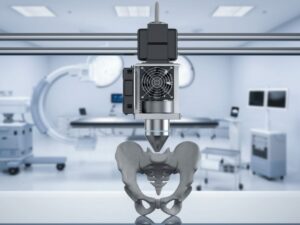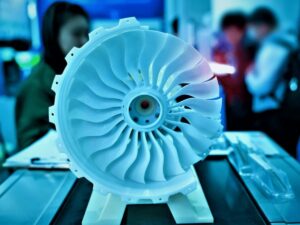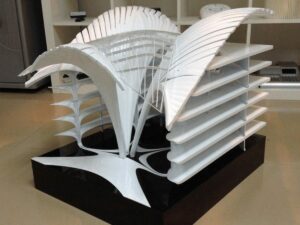Ever wondered why businesses are increasingly turning to China for rapid prototyping services? The answer lies in the remarkable advantages offered by the rapidly evolving Chinese manufacturing landscape. However, navigating this vast and diverse market can be challenging, often leaving businesses perplexed.
This comprehensive guide will demystify China’s rapid prototyping services, outlining their types, benefits, applications, and challenges. Furthermore, we’ll guide you on how to choose the right service provider for your unique needs.
Get ready for a deep dive into this transformative manufacturing technology!
1. Brief Overview of Rapid Prototyping Services in China
Over the last few decades, China has steadily redefined its position in the global manufacturing landscape through its mastery of rapid prototyping technologies. This game-changing manufacturing approach involves creating physical parts, models, or assemblies using three-dimensional computer-aided design (CAD) data, providing a quick and effective bridge between the digital design and the physical product.

2. The Rise of Rapid Prototyping in China
In the world of manufacturing, few trends have been as transformative and impactful as the rise of rapid prototyping in China. Driven by the country’s relentless push towards innovation and industrial upgrading, believe me, this phenomenon has not only reshaped China’s domestic manufacturing sector but has also attracted global businesses.
3. Benefits of China’s Rapid Prototyping Services
As the global epicenter of manufacturing, China offers unique benefits when it comes to rapid prototyping services. Here’s an in-depth exploration of what makes China’s rapid prototyping services stand out.
Speed and Efficiency
China’s rapid prototyping services are second to none in delivering speedy and efficient results. Thanks to advanced machinery and streamlined processes, businesses can expect a quicker transition from design to prototype, drastically reducing the time to market. This efficiency is a major selling point for businesses in today’s market, where agility and speed often make the difference between success and failure.
Cost-Effectiveness
According to BDC, understanding your costs is vital for informed business decisions. Here again, China’s rapid prototyping services shine. Leveraging the power of economies of scale, coupled with a well-developed manufacturing ecosystem, businesses can take advantage of significantly lower costs compared to other countries.
High Precision and Quality
Quality and precision are two attributes synonymous with China’s rapid prototyping services. Chinese manufacturers employ the latest technologies and maintain strict quality control measures, ensuring each prototype is created with high precision and consistency. This commitment to quality is paramount in industries where even the slightest error can lead to significant issues, such as aerospace and healthcare.
Wide Range of Materials and Processes
The diversity in materials and processes offered by China’s rapid prototyping services is astounding. Whether it’s metal, plastic, or rubber, businesses can select from an extensive range of materials to perfectly suit their product specifications. Various prototyping processes, including 3D printing, CNC machining, and injection molding, cater to a variety of product complexities and volumes, offering immense flexibility to businesses.

Customization Opportunities
Customization is key to standing out. For instance, China’s rapid prototyping services provide a plethora of customization opportunities, enabling businesses to create prototypes tailored to their specific requirements. From altering material properties to tweaking design aspects, Suproto’s services enhance product differentiation, thereby giving businesses a unique edge.
4. Types of Rapid Prototyping Services in China
China’s rapid prototyping services encompass a broad spectrum of technologies, each with its unique features and benefits. Here, let’s delve into some of the most prominent types of rapid prototyping services offered in China:
3D Printing Services
3D printing, or additive manufacturing, is a technology that’s at the forefront of rapid prototyping services in China. It builds parts layer-by-layer from a digital file, enabling the creation of complex geometries and structures that would be impossible with traditional manufacturing methods. The versatility of 3D printing allows for the use of a variety of materials, including plastics, resins, metals, and even ceramics.
CNC Machining Services
CNC machining is a subtractive manufacturing process popular in China’s rapid prototyping industry. It involves the use of computer-controlled machines to remove material from a workpiece, achieving high precision and repeatability. CNC machining is particularly suited for creating prototypes out of the actual production-grade material, leading to highly accurate and functional testing components.
Injection Molding Services
Injection molding is a widely used prototyping method in China, especially for large-scale production. It involves injecting molten material into a mold to create parts. In my opinion, while the initial cost for the mold can be high, the cost per unit during injection molding is extremely low, making it an ideal option for mass production of prototypes.
Vacuum Casting Services
Vacuum casting is a cost-effective method for producing high-quality prototypes or small batches of parts. It involves creating a silicone mold from a master model and then using a vacuum to draw liquid material into the mold. This process is popular due to its ability to produce parts with fine details and excellent surface quality.
Sheet Metal Fabrication Services
Sheet metal fabrication involves creating parts from metal sheets. Techniques such as laser cutting, bending, punching, and welding are used to form the desired parts. Given its durability and heat resistance, sheet metal fabrication is often used in industries like automotive and electronics.
5. Applications of Rapid Prototyping in China
Rapid prototyping has been a transformative force across a multitude of industries. Here, we’ll explore how various industries are leveraging rapid prototyping in China.
Automotive Industry
In the automotive industry, rapid prototyping is used for creating prototypes of new car parts, from simple components to complex assemblies. Based on experience, this helps manufacturers to test and validate designs quickly before moving to full-scale production, thereby reducing costs and time to market.

Medical Devices and Healthcare
The healthcare sector has greatly benefited from rapid prototyping, especially in the creation of medical devices. For example, prototyping has facilitated the development of highly customized and complex products, like prostheses and surgical tools. Furthermore, it’s revolutionizing biotechnology with the potential to 3D print human tissues and organs.

Consumer Electronics
Rapid prototyping plays a pivotal role in the consumer electronics industry. It aids in the design and testing of new products, like smartphones and wearables. Anyone will agree that given the industry’s fast-paced nature, rapid prototyping allows for quick iterations and adaptations to design based on consumer feedback.

Aerospace and Defense
In the aerospace and defense industry, the precision, quality, and variety of materials offered by rapid prototyping are highly valued. It aids in the development of parts and components with high-performance requirements and allows for rigorous testing before implementation.

Architecture and Construction
In architecture and construction, rapid prototyping provides an efficient way to create scale models for visualization and structural analysis. It helps architects and engineers to detect and correct errors in the early design phase, avoiding costly corrections later on.

6. Challenges Faced by Rapid Prototyping Services in China
While China’s rapid prototyping services offer an array of benefits, it’s also essential to recognize the challenges that businesses might encounter. Below are some obstacles that can equip businesses to devise effective strategies to mitigate them:
Intellectual Property Concerns
One of the most frequently cited concerns for foreign businesses operating in China is the protection of intellectual property rights. While the Chinese government has been working to strengthen IP laws, it’s still crucial for businesses to take protective measures, like registering patents and trademarks in China and carefully vetting partners and suppliers.
Rising Labor Costs
While China has traditionally been known for its low labor costs, these costs have been steadily rising in recent years. This trend has been due to factors like economic development, labor law reforms, and demographic changes. I highly suggest that businesses must factor these rising costs into their decision-making process.
Quality Consistency Issues
While many Chinese rapid prototyping service providers deliver high-quality products, maintaining consistent quality can sometimes be a challenge. This inconsistency can be attributed to factors like differing standards, workforce skills, or quality control processes. The solution is, businesses must diligently monitor quality and work closely with their Chinese partners to ensure consistency.
7. How To Choose the Right Rapid Prototyping Service in China
Choosing the right rapid prototyping service in China can be a complex task given the vast array of service providers. To ensure a successful collaboration, here are a few critical factors to consider:
Assessing your Project Requirements
You need to have a clear understanding of your project requirements. This includes factors like the complexity of your prototype, the materials you plan to use, your budget, and your timeline. In my opinion, your choice of service provider should be able to meet these requirements effectively.
Evaluating the Service Provider
According to Mind Tools, look at how competent the supplier is. Make a thorough assessment of their capabilities, and measure them against your needs. Check their experience, reputation, technical capabilities, and quality control processes. Customer reviews and case studies can offer valuable insights. Also, ensure they have robust communication channels to facilitate smooth collaboration.
Understanding the Pricing Models
Understanding the pricing models of different service providers is crucial. Trust me, some might offer lower prices but compromise on quality or have hidden fees. At Suproto, you can ensure that our pricing model is transparent, and you are clear about what you are paying for.
This table provides a concise overview of the key factors to consider when selecting a rapid prototyping service in China, including project requirements, supplier evaluation, communication channels, and pricing models, along with additional considerations for each factor.
| Factors to Consider |
Description |
Additional Considerations |
| Project Requirements |
Assess your project requirements, including the complexity of the prototype, desired materials, budget, and timeline. Ensure the service provider can meet these requirements. |
Consider if the service provider offers customization options, scalability for future projects, and confidentiality measures. |
| Supplier Evaluation |
Evaluate the competence of the service provider by assessing their experience, reputation, technical capabilities, and quality control processes. |
Look for certifications, expertise in specific industries, the availability of advanced technology, and intellectual property protection measures. |
| Communication Channels |
Check if the service provider has robust communication channels to facilitate smooth collaboration throughout the project. |
Consider the availability of project managers or dedicated contacts, responsiveness to inquiries, and language proficiency. |
| Pricing Models |
Understand the pricing models of different service providers. Ensure transparency and clarity regarding costs, avoiding compromises on quality or hidden fees. |
Evaluate the flexibility of pricing options, discounts for bulk orders, and the overall value provided for the cost. |
Conclusion
Navigating the world of rapid prototyping services in China can be a complex process. However, with a deep understanding of the benefits, types, applications, and challenges, along with a well-defined strategy for choosing the right service, businesses can leverage these services to innovate, reduce costs, and accelerate product development.
If you are looking for a trusted rapid prototyping service provider in China, look no further than Suproto. With a proven track record and a comprehensive range of services, we are committed to helping businesses turn their product ideas into reality. Contact us today to learn how we can support your prototyping needs.







